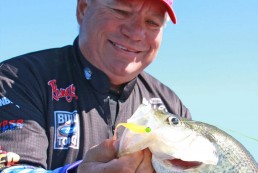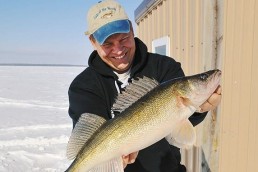Ten Tips for Tackling Crappies in Fall and Winter
SHARE THIS POST
A successful day on the lake often comes from doing a series of things correctly. Tips, tactics and presentations used by guides, tournament fishermen and other experts put the odds for success in their favor.
Fall and early winter is a great time for you to give these a try as well:
Tip 1: Jig wood throughout the strike zone.
Drop all the way to the bottom and bring the jig up slowly. If the wood or bed is in 20 feet of water sticking up to 15 feet, work the jig from 20 feet up to about 12 and repeat. Bites can be very light or feel like hard thumps, but a slow presentation is critical for drawing strikes. Lift the bait about 1 foot and stop, hold and then repeat.
Tip 2: Use a jig.
Cooler and much colder waters trigger something in crappies that make them hit artificial baits better than in the summer and fall. Tipping with a waxworm or a small minnow can help too.
Tip 3: Use live bait.
Funny tip after the last one about jigs, however, a small or medium minnow gives off a natural scent, look and action. A minnow is a good choice when conditions are tough. The disadvantage of one is that it can’t be fished as fast or as versatile as a jig.
Tip 4: Don’t keep doing what isn’t working.
If you’re fishing rock piles on a point and nothing is biting, move to a ledge with wood cover. The theory is that some of the fish are biting somewhere so it’s the fisherman’s job to search and adjust. Work baits slowly, but move if something isn’t working.
Tip 5: Buy good equipment.
Pros understand that a weekend fisherman can’t afford to buy all the tools and toys they use. However, pros say it’s important to be selective about what you buy. Purchase quality items for better performance and longer life. Buy fewer, but be sure to buy quality for the ones you can afford.
Are you enjoying this post?
You can be among the first to get the latest info on where to go, what to use and how to use it!
Tip 6: Pay attention to jig weight.
Fishermen in the North have used micro-baits for years under the ice; weights of 1/32, 1/48, 1/64 ounce are choices. Southern fishermen use a variety of jig weights, but 1/16 and 1/8 ounce is the most popular. The 1/32-ounce bait is usually reserved for shooting docks and super-shallow presentations. For jig weight, there are typically three factors: depth, water clarity and a crappie’s size preference. Lightweight baits take a while to sink, so shallower presentations are ideal. Heavier jigs are good for deep water and in windy conditions. Sometimes finicky, coldwater crappies prefer a small offering and nothing else. There are no rules that fit all situations—figuring out the fish is part of the fun and the challenge.
Tip 7: Use slip-float minnow rigs.
Slip floats are good year ‘round, but are especially excellent for fishing deeper waters. Long-lob casts can be made because the hook, sinker and float are all near the end of the line. When everything hits the water, line flows through the float until it reaches a stop placed by the fisherman at the depth selected. The bait stays at the precise depth and the float is the strike indicator. A small or medium minnow does the work down below. One of my favorite methods is to mark a good crappie spot and get parallel to the wind or current before anchoring. When anchored at the side, casts can be made upwind or up current by letting the bait just drift across the spot. This strategy provides a natural presentation with current or wind. Where legal, use two or three poles, making all casts upwind/up current from the spot. After the bait crosses, reel in and cast. You’ll always have one or two baits floating across the prime strike zone.
Tip 8: Have a logical game plan.
Give yourself a good chance for success. Read MidWest Outdoors for the latest fishing reports and pay special attention to depths at which crappies are being caught, and in what type of spot. Also, call or visit the bait shops in a particular area you’re fishing, as they can have the latest news. Your game plan should include plans A, B, C, and D. When plan “A” doesn’t work, continue making changes, which can include the depths, presentations, areas, cover and baits. Experience on a lake during the fall and early winter helps, but anyone can use a game plan to test different depths and spots to learn a pattern.
Tip 9: Electronics are important.
“Electronics is a key to catching crappies this time of year,” said Wally Marshall, “Mr. Crappie,” and Strike King pro staffer. “At minimum, you need a sonar and GPS. The sonar lets you find contours, cover and see fish depths; the GPS lets you mark beds, ledges and other structure so you can build up a list of fishing spots where you can go to catch crappies.”
Tip 10: Jigging is more fun.
“A lake like Kentucky Lake can be slow-trolled or spider-rigged,” Marshall says, adding to the last tips. “That’s what everyone does. But I believe when fish are in stake beds and brush piles I prefer jigging. One pole is more fun than four rods stuck in holders. I know the numbers of hooks can mean more fish, but with jigging I’ll have more fun, go one-on-one with the crappie and might catch just as many fish.”
There isn’t an absolute guarantee for success at all times in the colder waters, but by tweaking the bait or your presentation or using a proven tactic, you can give yourself the advantage and put more crappies on the end of your line. Try these tips and experiment on your own to create an enjoyable trip on your lake.
MWO
SHARE THIS POST
Did you enjoy this post?
You can be among the first to get the latest info on where to go, what to use and how to use it!
Tim Huffman
Tim Huffman specializes in crappie fishing, is editor for two crappie magazines, as well as writing for several others. In 2018, he published his sixth book, Limiting Out for Crappie, available at Amazon. His first article appeared in MidWest Outdoors in 1988.



